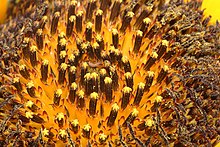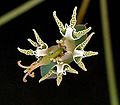
A panicle is a much-branched inflorescence. Some authors distinguish it from a compound spike inflorescence, by requiring that the flowers be pedicellate. The branches of a panicle are often racemes. A panicle may have determinate or indeterminate growth.
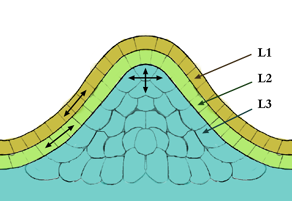
The meristem is a type of tissue found in plants. It consists of undifferentiated cells capable of cell division. Cells in the meristem can develop into all the other tissues and organs that occur in plants. These cells continue to divide until they become differentiated and lose the ability to divide.

A raceme or racemoid is an unbranched, indeterminate type of inflorescence bearing flowers having short floral stalks along the shoots that bear the flowers. The oldest flowers grow close to the base and new flowers are produced as the shoot grows in height, with no predetermined growth limit. Examples of racemes occur on mustard, radish, and orchid plants.

In botany, a bract is a modified or specialized leaf, especially one associated with a reproductive structure such as a flower, inflorescence axis or cone scale. Bracts are usually different from foliage leaves; they may be of a different size, color, shape, or texture. Typically, they also look different from the parts of the flower, such as the petals or sepals. A plant having bracts is referred to as bracteate or bracteolate, while one that lacks them is referred to as ebracteate and ebracteolate, without bracts.

Commelina is a genus of approximately 170 species commonly called dayflowers due to the short lives of their flowers. They are less often known as widow's tears. It is by far the largest genus of its family, Commelinaceae. The Swedish taxonomist Carl Linnaeus of the 18th century named the genus after the two Dutch botanists Jan Commelijn and his nephew Caspar, each representing one of the showy petals of Commelina communis.

Sympodial growth is a bifurcating branching pattern where one branch develops more strongly than the other, resulting in the stronger branches forming the primary shoot and the weaker branches appearing laterally. A sympodium, also referred to as a sympode or pseudaxis, is the primary shoot, comprising the stronger branches, formed during sympodial growth. The pattern is similar to dichotomous branching; it is characterized by branching along stems or hyphae.

Aralia spinosa, commonly known as devil's walking stick, is a woody species of plant in the genus Aralia of the family Araliaceae. It is native to eastern North America. The various names refer to the viciously sharp, spiny stems, petioles and even leaf midribs. It has also been known as Angelica-tree.

Corymb is a botanical term for an inflorescence with the flowers growing in such a fashion that the outermost are borne on longer pedicels than the inner, bringing all flowers up to a common level. A corymb has a flattish top with a superficial resemblance towards an umbel, and may have a branching structure similar to a panicle. Flowers in a corymb structure can either be parallel, or alternate, and form in either a convex, or flat form.
In botany, an umbel is an inflorescence that consists of a number of short flower stalks that spread from a common point, somewhat like umbrella ribs. The word was coined in botanical usage in the 1590s, from Latin umbella "parasol, sunshade". The arrangement can vary from being flat-topped to almost spherical. Umbels can be simple or compound. The secondary umbels of compound umbels are known as umbellules or umbellets. A small umbel is called an umbellule. The arrangement of the inflorescence in umbels is referred to as umbellate, or occasionally subumbellate.

In biology and botany, indeterminate growth is growth that is not terminated in contrast to determinate growth that stops once a genetically pre-determined structure has completely formed. Thus, a plant that grows and produces flowers and fruit until killed by frost or some other external factor is called indeterminate. For example, the term is applied to tomato varieties that grow in a rather gangly fashion, producing fruit throughout the growing season. In contrast, a determinate tomato plant grows in a more bushy shape and is most productive for a single, larger harvest, then either tapers off with minimal new growth or fruit or dies.

A pseudanthium is an inflorescence that resembles a flower. The word is sometimes used for other structures that are neither a true flower nor a true inflorescence. Examples of pseudanthia include flower heads, composite flowers, or capitula, which are special types of inflorescences in which anything from a small cluster to hundreds or sometimes thousands of flowers are grouped together to form a single flower-like structure. Pseudanthia take various forms. The real flowers are generally small and often greatly reduced, but the pseudanthium itself can sometimes be quite large.
This page provides a glossary of plant morphology. Botanists and other biologists who study plant morphology use a number of different terms to classify and identify plant organs and parts that can be observed using no more than a handheld magnifying lens. This page provides help in understanding the numerous other pages describing plants by their various taxa. The accompanying page—Plant morphology—provides an overview of the science of the external form of plants. There is also an alphabetical list: Glossary of botanical terms. In contrast, this page deals with botanical terms in a systematic manner, with some illustrations, and organized by plant anatomy and function in plant physiology.
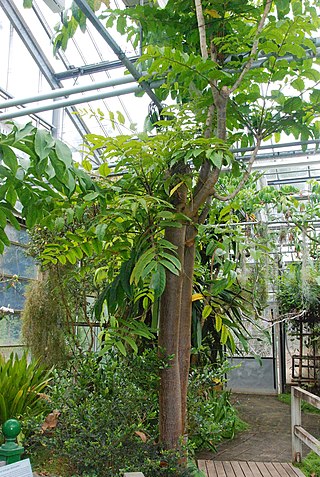
Polyscias aemiliguineae is a species of plant in the family Araliaceae. It is endemic to Réunion.
This glossary of botanical terms is a list of definitions of terms and concepts relevant to botany and plants in general. Terms of plant morphology are included here as well as at the more specific Glossary of plant morphology and Glossary of leaf morphology. For other related terms, see Glossary of phytopathology, Glossary of lichen terms, and List of Latin and Greek words commonly used in systematic names.

Corymbium is a genus of flowering plants in the daisy family comprising nine species. It is the only genus in the subfamily Corymbioideae and the tribe Corymbieae. The species have leaves with parallel veins, strongly reminiscent of monocots, in a rosette and compounded inflorescences may be compact or loosely composed racemes, panicles or corymbs. Remarkable for species in the daisy family, each flower head contains just one, bisexual, mauve, pink or white disc floret within a sheath consisting of just two large involucral bracts. The species are all endemic to the Cape Floristic Region of South Africa, where they are known as plampers.

Adenodaphne is a genus of shrubs and small trees endemic to New Caledonia belonging to the family Lauraceae. The genus is related to Litsea. They have 12 chromosomes.
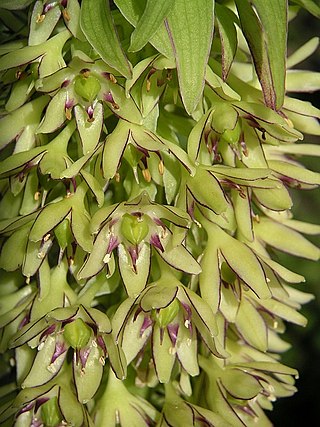
Eucomis bicolor, the variegated pineapple lily or just pineapple lily, is a bulbous species of flowering plant in the family Asparagaceae, subfamily Scilloideae, native to Southern Africa. The pale green, purple-margined flowers are arranged in a spike (raceme), topped by a "head" of green leaflike bracts. It is cultivated as an ornamental bulbous plant, although its flowers have an unpleasant smell, attractive to the main pollinators, flies.

Hypericum majus, the greater Canadian St. John's wort, is a perennial herb native to North America. The specific epithet majus means "larger". The plant has a diploid number of 16.
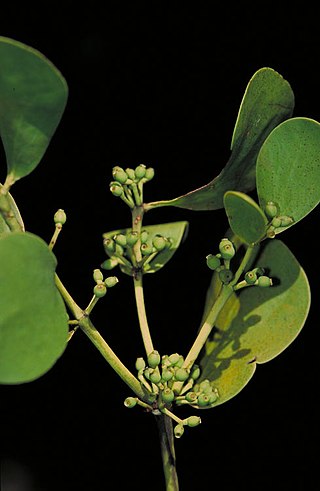
Cecarria is a monotypic genus in the family Loranthaceae. The sole species is Cecarria obtusifolia, a hemiparasitic aerial shrub.

Scaevola parvifolia is an erect, many stemmed perennial in the family Goodeniaceae, which is native to Western Australia, the Northern Territory, Queensland and South Australia. It grows to a height of 0.6 m, and its blue-purple flowers may be seen from March to October.


















